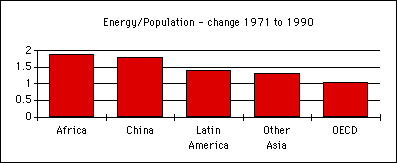Energy Use Trends
This section provides a brief overview of energy use in the US and the world. The key idea is that energy use is increasing everywhere, but far more rapidly in developing nations than in developed nations of the US. The implication is that efforts to address energy-induced global warming must emphasize developing nations.
US Energy Use | Global Energy Use |
| It is the mark of an instructed mind to rest satisfied with the degree of precision which the nature of the subject permits and not to seek an exactness where only an approximation of the truth is possible. Aristotle |
US Energy Use
In 1994 the US used 88.5 quadrillion BTU (British Thermal Units, where 1 BTU = 10^15 BTU) of commercial energy. The term "commercial energy" refers generically to energy for which money is paid; the definition excludes, for example, solar energy input to crop growth and energy that drives rain that fills reservoirs. When the potential energy of water is converted to electricity which is sold, the electricity does become part of the "commercial energy" category.Commercial energy is conventionally broken down into three sectors: residential/ commercial sector used 31.3 quads, industry used 33.7 quads, and transportation used 23.5 quads.
Energy use in the US is divided among three major sectors, Transportation, commercial and industry. source: Annual Energy Review, 1994:9
Sources of United States Energy: a Two Decade Perspective
Table 1. U.S. energy consumption before the oil embargo (1973) and two decades later (1994). The data are in quads (10^15 BTU) per year. (Start "*" denote approximate corrections to biofuels to conform to 1990 book-changing.) Data from Annual Energy Review, EIA, 1994, p. 9.Table 1. Renewable Energy
| hydro | geo | wind | solar | biofuel | Total Renew | Total E Used |
| 2.9 | 0.04 | 0 | 0 | 2.3* | 5.2* | 76.6* |
| 2.7 | 0.27 | 0.04 | 0.07 | 2.8 | 5.8 | 88.5 |
Table 2. Non-renewable Energy
| oil | natural gas | coal | Total Fossil | % fossil | |
| 1973 | 34.8 | 22.5 | 13 | 70.3 | 0.92 |
| 1994 | 34.6 | 21.2 | 19.5 | 75.4 | 0.85 |
Total energy use increased by 13.4% during the two decades. Almost all this increase was accounted for by coal and nuclear. There was an increase in the contribution of renewable energy from 8% in 1973 to 15% in 1994. Whether these trends will continue over the next two decades is of great importance. Coal is a "bad actor" in terms of potential to induce global warming. There have been no new orders for nuclear power plants for many years, and the current prospects are for a decline in total energy produced by nuclear plants.
Table 3 shows the percentage changes in each of these sources of supply. Coal and nuclear increased sharply, but the nuclear base was very low. Biomass increased by a significant percentage, but also from a small base.
Table 3. Percentage changes in the number of quads
delivered by various energy forms from 1973 to 1994
| oil | - 1 % |
| natural gas | - 6% |
| coal | + 33% |
| nuclear | + 87% |
| hydro | + 3% |
| biomass | + 18% |
The primary energy input to generate electricity was 30.9 quads. About 2/3 of the energy was lost in conversion processes, leaving about 10 quads as electricity . Of the delivered energy about 2/3 was delivered to the residential/commercial sector and 1/3 to industry.
Electricity as a percentage of total US energy use has been increasing ever since electricity was introduced. In 1973 about 25% of primary energy used to make electricity. In 1974 the percentage of energy used to make electricity had increased to 34% of total energy.
References
- Annual Energy Review, U.S. Energy Information Agency (EIA), 1994.
- U.S. Dept. Energy, Report DoE/CH/00016-H2
- J. Goldemberg, T. Johansson, A. Reddy and R. Williams, Energy for a Sustainable World (New Delhi: Wiley Eastern Limited, 1988).
- M. Levine and M. Hirose, Energy Efficiency Improvement Utilizing High Technology: An Assessment of Energy Use in Industry and Buildings; Report and Case Studies, World Energy Council, 34 St James's Street, London SW1A 1HD, United Kingdom, 1995.
World Energy Use
This section summarizes global energy use. The units used here are exajoules/year.[1 quad/year = 1.05 exajoules]. These units area used to conform to international convention.World total energy use has been increasing at 2.3%/year, which corresponds to a doubling time of 31 years.
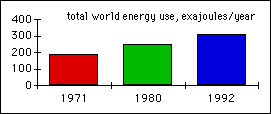
World Energy use in 1971, 1980 and 1992, in exajoules per year.
1.05 exajoules/year = 1 quad/year
Total energy has been increasing. The following three figures illustrates how the increase has occurred preferentially in the developing nations, where the share of energy has increased from 14% in 1991 to 26% in 1992. Proportions of energy are shown for 1971, 1980, and 1992
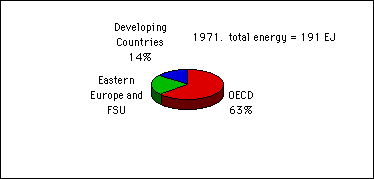
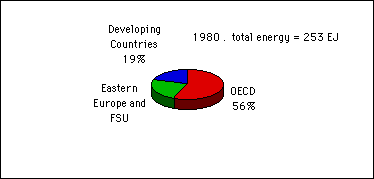
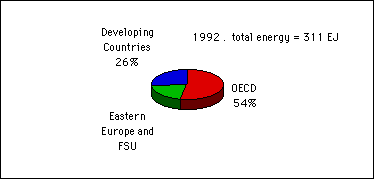
Distribution of energy use in three major parts of the world. OECD energy use has decreased as a fraction of the total. source: Levine and Hirose 1995
The next table shows how this growth breaks down by region.
Global Energy Consumption by Sector and Region, 1991-1992.
Source: Levine and Hirose 1994:4
| 1971 | 1980 | 1992 | avg Ann Growth Rate %/year [1971-1992] | |
| OECD Countries | ||||
| Industry | 50 | 57 | 60 | 0.8 |
| Buildings | 45 | 54 | 66 | 1.9 |
| Transport | 25 | 31 | 39 | 2.1 |
| Regional Total | 120 | 142 | 165 | 1.5 |
| Eastern Europe and the Former Soviet Union | ||||
| Industry | 26 | 34 | 32 | 0.9 |
| Buildings | 12 | 20 | 22 | 3 |
| Transport | 6 | 8 | 9 | 2 |
| Regional Total | 44 | 62 | 63 | 1.7 |
| Developing Countries | ||||
| Industry | 14 | 25 | 43 | 5.5 |
| Buildings | 7 | 13 | 25 | 6.2 |
| Transport | 5 | 9 | 14 | 4.7 |
| Regional Total | 27 | 48 | 82 | 5.5 |
| World | ||||
| Industry | 90 | 116 | 134 | 1.9 |
| Buildings | 64 | 88 | 113 | 2.8 |
| Transport | 37 | 49 | 63 | 2.6 |
| Total | 191 | 253 | 311 | 2.3 |
Regions of the world have changed over time in very different ways. The next figure shows national income, energy and population in 1973 to 1990. The ordinate is the ratio of the value in 1990 to that in 1973. National income has gone up by a factor of 3.6 in China, compared to only 1.6 [60% increase) in the OECD nations. China and Africa have experienced the greatest energy growth. Population growth has been far lower in the OECD nations than elsewhere in the world. The rapid growth in energy use in the developing nations reinforces the reality that measures to combat energy induced global climate change must focus on these nations.
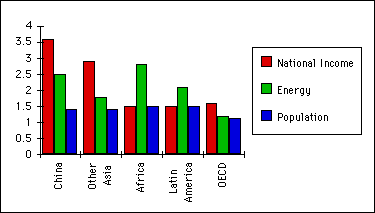
| National Income | Energy | Population | |
| China | 3.6 | 2.5 | 1.4 |
| Other Asia | 2.9 | 1.8 | 1.4 |
| Africa | 1.5 | 2.8 | 1.5 |
| Latin America | 1.5 | 2.1 | 1.5 |
| OECD | 1.6 | 1.2 | 1.15 |
Changes over the 1973-1990 period in income, energy use and population
in the four major regions of the world. Source: Levine and Hirose, 1995:9
The last figure shows how energy use per capita has changed from 19171 to 1990 in the major regions of the world. Africa and China have increased their per capita use most. The change in OECD nations has been slight, which means energy use per capita has been almost constant over this period.
Conclusion
In recent decades energy use in developing nations has increased far more rapidly than in the developed nations. This trend suggests that policy relating to global climate change must place special emphasis on developing nations, and on particularly on coal use.
References
- Annual Energy Review, U.S. Energy Information Agency (EIA), 1994.
- 2. U.S. Dept. Energy, Report DoE/CH/00016-H2
- J. Goldemberg, T. Johansson, A. Reddy and R. Williams, Energy for a Sustainable World (New Delhi: Wiley Eastern Limited, 1988).
- M. Levine and M. Hirose, Energy Efficiency Improvement Utilizing High Technology: An Assessment of Energy Use in Industry and Buildings; Report and Case Studies, World Energy Council, 34 St James's Street, London SW1A 1HD, United Kingdom, 1995.

